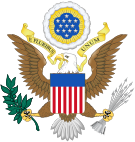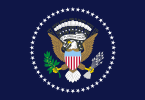President of the United States
| President of the United States of America | |
|---|---|
 | |
 | |
| Style | |
| Status | |
| Member of | |
| Residence | White House |
| Seat | Washington, D.C. |
| Nominator |
|
| Appointer | Electoral College |
| Term length | Two four-year terms |
| Constituting instrument | United States Constitution |
| Formation | March 4, 1789[4][5] |
| First holder | George Washington[6] |
| Salary | $400,000 annually[upper-alpha 1] |
| Website | whitehouse |
| This article is part of a series on the |
| Politics of the United States of America |
|---|
 |
|
|
The President of the United States of America is the head of state, and head of government of the United States. The office of President was created in the United States Constitution in 1788. The first President (George Washington) took office in 1789. The President serves as chief executive and is in charge of the executive branch of the United States government. The United States Constitution makes the President the Commander-in-Chief of the armed forces. It also lists powers given to the President, though these powers have been expanded through practice over time.
On November 9, 2016, Donald Trump was elected to be the 45th President of the United States, not including Grover Clevlend's second non-consecutive term. Grover Cleveland served two non-consecutive terms in office, and is counted as the nation's 22nd and 24th president. Thus the incumbent, Donald Trump, is the nation's 45th president. There are currently four living former presidents. The most recent death of a former president was on November 30, 2018 with the death of George H. W. Bush; the most recently serving president to die was also George H. W. Bush on November 30, 2018. The current President was formally inaugurated on January 20, 2017, succeeding Barack Obama.
Contents
Requirements[change | change source]
Article II, Section 1, Clause 5 of the Constitution sets the requirements to hold office. A president must:
- be a natural-born citizen of the United States. [note 1]
- be at least thirty-five years old. Theodore Roosevelt, 42, was the youngest, and Donald Trump, 70, is the oldest.
- be a permanent resident in the United States for at least fourteen years.
Election process and terms[change | change source]
The president is indirectly elected by the people through the Electoral College to a four-year term, and is one of only two nationally elected federal officers, the other being the Vice President of the United States.[8] A president must receive more than 270 electoral college votes in order to win an election. Ronald Reagan received 525 votes which is the most electoral votes of any other president.
A president can only serve two terms as president, which is 8 years. Franklin D. Roosevelt served four terms as president. He died while beginning his fourth term. After his death, congress passed an amendment which limits the number of terms a president can have.
William Henry Harrison served the shortest term, one month, because he died in office from pneumonia.
Inaugurations[change | change source]
A president officially becomes president after being inaugurated on January 20th. The president must be given the oath of office by the Chief Justice of the United States. It is traditionally held at the United States Capitol.
Primary functions[change | change source]
- Enforcing laws passed by the United States Congress
- Nominating a Cabinet of advisors
- Giving pardons or reprieves
With the agreement of the United States Senate he or she can:
- Make treaties
- Choose ambassadors to foreign countries
- Select Judges, and Justices of the Supreme Court
| President | Date of birth | Presidency | |
|---|---|---|---|
| Jimmy Carter | October 1, 1924 | 39 | 1977–1981 |
| Donald Trump | June 14, 1946 | 45 | 2017– |
| George W. Bush | July 6, 1946 | 43 | 2001–2009 |
| Bill Clinton | August 19, 1946 | 42 | 1993–2001 |
| Barack Obama | August 4, 1961 | 44 | 2009–2017 |
Succession[change | change source]
If the president dies/retires between elections or is otherwise removed from office, the Acting President will become president, who is usually the Vice President.
Abraham Lincoln, James A. Garfield, William McKinley, and John F. Kennedy were assassinated while in office. William Henry Harrison, Zachary Taylor, Warren G. Harding, and Franklin Roosevelt died from illness while president. John Tyler was the first Vice President of the United States to become president.
Gerald Ford, Richard Nixon's vice president, became president after Nixon resigned. Nixon is the only president to have resigned.
Traveling[change | change source]
A president travels by either traveling on Air Force One, Marine One, or by the Presidential state car. At all times, the president is protected by Secret Service agents. Sometimes, the president may travel to Camp David for either relaxation or to do some work in peace.
List of Presidents of the United States[change | change source]
Living former presidents[change | change source]
Jimmy Carter
(1977 – 1981)
October 1, 1924
Bill Clinton
(1993 – 2001)
August 19, 1946
George W. Bush
(2001 – 2009)
July 6, 1946
Barack Obama
(2009 – 2017)
August 4, 1961
Presidential rankings[change | change source]
By a majority of historical sources by historians or by the American people; George Washington, Thomas Jefferson, Abraham Lincoln, Woodrow Wilson, Franklin D. Roosevelt, Harry S. Truman, Dwight D. Eisenhower, John F. Kennedy, Ronald Reagan, George H. W. Bush, and Bill Clinton are ranked high on polls.
On the other hand; James Buchanan, Warren G. Harding, Herbert Hoover, Lyndon B. Johnson, Richard Nixon, Jimmy Carter, and George W. Bush are thought to be the worst.
Presidential libraries[change | change source]
Since Herbert Hoover, each president has created a institutional place known as a presidential library for preserving and making available his papers, records and other documents and materials. There are currently thirteen presidential libraries in the NARA system.
There are also presidential libraries maintained by state governments and private foundations, such as the Abraham Lincoln Presidential Library and Museum, which is run by the State of Illinois.
Several presidential libraries contain the graves of the president such as Richard Nixon at his library in Yorba Linda, California and Ronald Reagan at his library in Simi Valley, California.
Sources[change | change source]
- ↑ "How To Address The President; He Is Not Your Excellency Or Your Honor, But Mr. President". The New York Times. August 2, 1891.
- ↑ "USGS Correspondence Handbook – Chapter 4". Usgs.gov. July 18, 2007. Archived from the original on September 26, 2012. Retrieved November 15, 2012.
- ↑ "Models of Address and Salutation". Ita.doc.gov. Retrieved September 4, 2010.
- ↑ Maier, Pauline (2010). Ratification: The People Debate the Constitution, 1787–1788. New York, New York: Simon & Schuster. p. 433. ISBN 978-0-684-86854-7.
- ↑ "March 4: A forgotten huge day in American history". Philadelphia: National Constitution Center. March 4, 2013. Retrieved July 29, 2018.
- ↑ "Presidential Election of 1789". Digital Encyclopedia. Mount Vernon, Virginia: Mount Vernon Ladies' Association, George Washington's Mount Vernon. Retrieved July 29, 2018.
- ↑ "How common is Trump's $1 salary?". BBC World Service. November 14, 2016. Retrieved January 22, 2017.
- ↑ Our Government • The Executive Branch, The White House.
Notes[change | change source]
- ↑ Foreign-born American citizens who met the age and residency requirements at the time the Constitution was adopted were also eligible for the presidency. However, this allowance has since become obsolete.
Other websites[change | change source]
| Wikimedia Commons has media related to President of the United States. |
- "Executive Office of the President". Retrieved January 21, 2009.
- "White House". Retrieved October 7, 2005.
.jpg/175px-Donald_Trump_official_portrait_(cropped).jpg)






